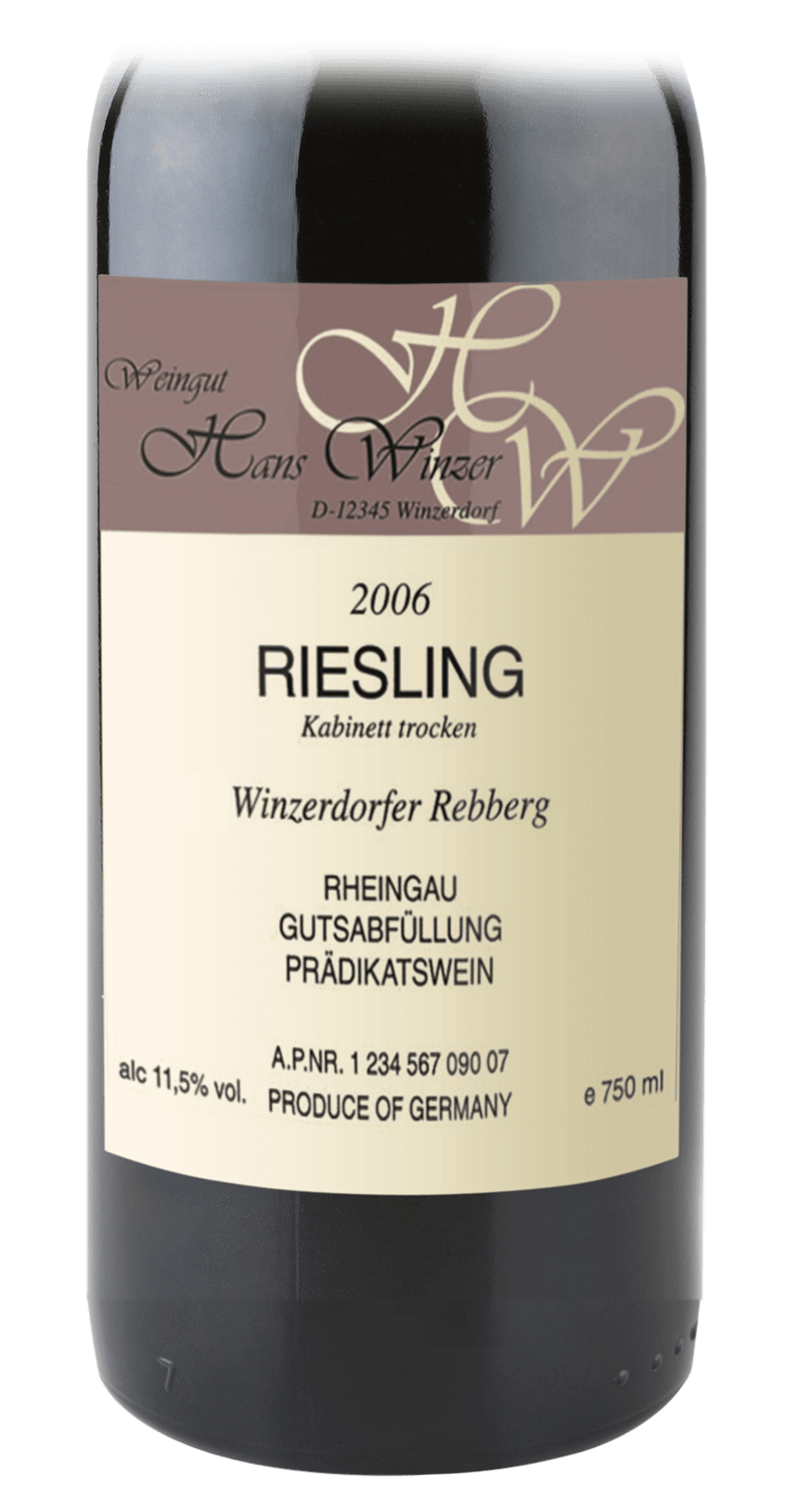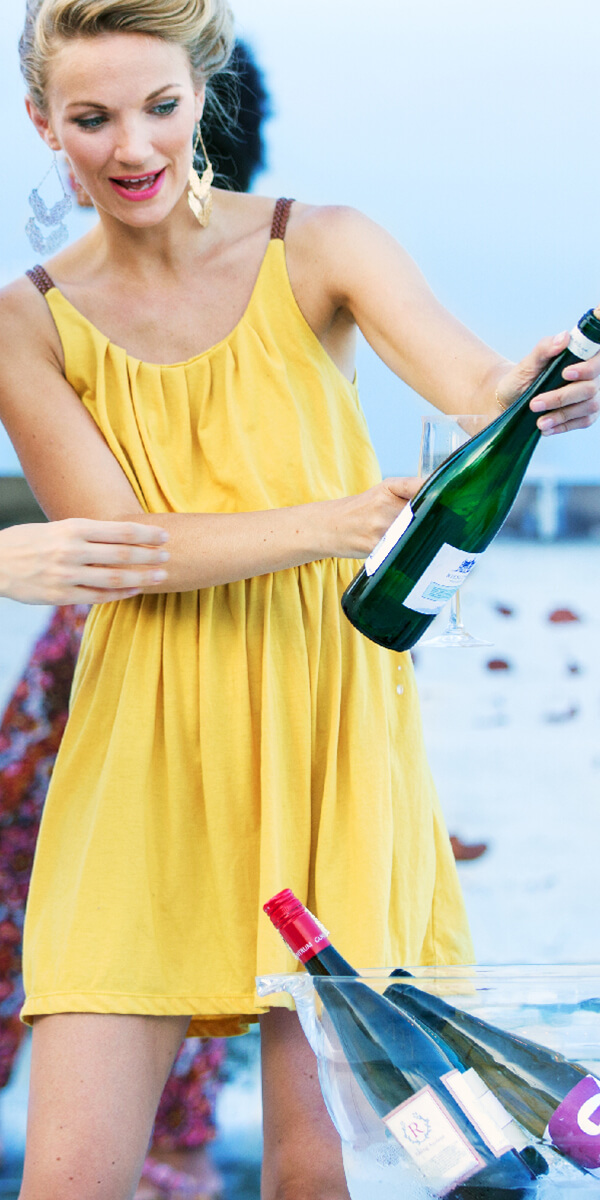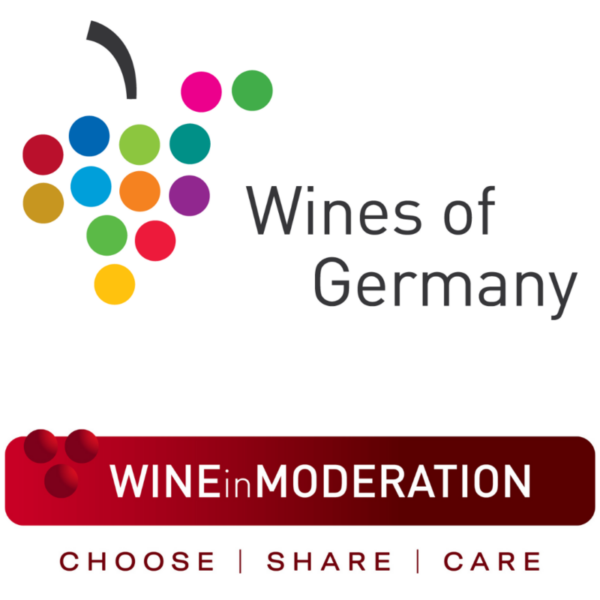
Reading a Wine Label
1. Producer vs. Bottler
Name of producer or estate, in this case the producer is Hans Winzer.
2. Vintage
The vintage is the year the grapes were harvested.
3. Grape Variety
The grape variety used to make a wine is the single most influential factor determining its taste. Different grapes have different flavors, just like different fruits have different flavors.
4. Ripeness Categories
The quality categories are Deutscher Wein, Deutscher Landwein, Qualitätswein, and Prädikatswein. The latter is further divided into the ripeness levels Kabinett, Spätlese, Auslese, Beerenauslese, Trockenbeerenauslese, and Eiswein.
5. Level of Dryness
The taste/style or level of dryness of a wine depends on the cellar master and is determined in the cellar by the winemaker.
6. Village and Vineyard
The often difficult to pronounce names on the label indicate the village where the vineyard is located (identified by the –er suffix) followed by another name (often ending in –berg [mountain, slope]) indicating the vineyard site.
7. Appellation of Origin
One of Germany’s 13 official wine-growing regions: Ahr, Mittelrhein, Mosel, Rheingau, Nahe, Pfalz, Rheinhessen, Franken, Hessische Bergstrasse, Württemberg, Baden, Saale-Unstrut, Sachsen.
8. Producer vs. Bottler
There are about 100,000 grape growers in Germany, yet only about one fourth as many wine producers. If the label indicates “Erzeugerabfüllung” (estate bottled), it assures you that the grapes were grown and the same grower or cooperative of growers produced the wine. Alternatively, estates and growers that grow, produce, and bottle their own wine can use the term “Gutsabfüllung” on the label. The grower or collective group of growers is responsible for and guarantees the quality of the wine. Sometimes the bottlers or shipper will assume responsibility and will be identified on the label as “Abfüller.”
9. Quality Category
A quality category indicates minimum standards have been met, determined by regional organizations or government quality control boards. The categories range from Deutscher Wein (table wine) to Deutscher Landwein, Qualitätswein, and Prädikatswein. Alternatively, a winery may elect to join a national or regional association such as the VDP, in which case the association’s qualifications may be listed on the bottle.
10. AP Number
Simply speaking, this is the quality control number, like a “stamp of approval” from the testing center or review board.

Quality Categories
Now that you can navigate a label, you can learn to identify indicators of a quality wine. Quality assessment is usually the responsibility of regional regulatory organizations and government quality control boards. The establishment of quality categories and quality control testing are key elements of German wine law.
First, understand if the wine has been categorized as Deutscher Wein, Landwein, Qualitätswein, or Prädikatswein. Producers are required by German wine law to declare the wine’s quality category on the label, with each category guaranteeing certain minimum quality standards. Understanding each category’s standards will give you some insights as to the origin of the wine’s grapes and the wine’s alcohol content and style, for example.
Most German wines found in the US will fall under the third and highest quality categories and will, therefore, follow Qualitätswein and Prädikatswein labeling regulations.
-
Deutscher Wein (German Wine)
This is Germany’s table wine category. These wines are produced exclusively from grapes grown in Germany. Compared with other wine-growing countries, relatively small quantities of this quality level are produced in Germany. A total alcohol content of at least 8.5% by volume, but not more than 15%, and a total acidity of at least 3.5 g/l are required. The vintage or varietal may or may not be declared on the label.
-
Landwein: Wine with a protected geographical indication
At least 85% of the grapes for a Landwein must originate in the Landwein region named on the label. Landwein is typically Trocken (dry) or Halbtrocken (off-dry) in style.
-
Qualitätswein & Prädikatswein: Wine with a protected designation of origin
Wines within these categories account for the majority of German wines, especially in the US market. Qualitätswein (also listed on labels as “QbA”) and Prädikatswein must originate 100% from one district within one of the 13 German wine-growing regions, and the region must be declared on the label. They can only be made from legally recognized grapes permitted in Germany and must reach certain alcohol content as prescribed for the region, grape variety, and ripeness level.
Prädikatswein (formerly known as Qualitätswein mit Prädikat, abbreviated QmP) indicates a superior quality wine with special attributes, which must meet even more stringent requirements than Qualitätswein. Enrichment, the use of oak chips, and dealcoholization are prohibited. A Prädikat, or special attribute, describes the ripeness of the grapes and the type of harvest. Each Prädikat is outlined below.
A wine can also be considered high quality if you find “Gutswein,” “Ortswein,” “Erste Lage,” “Grosses Lage,” or “Grosses Gewächs” listed on the label. These terms are part of the classification system of an independent members-only association. In some cases, you may see these terms alongside “Qualitätswein” or “Prädikatswein.”
Dryness Levels
Once you recognize quality, the next step is to read the label for ripeness and dryness, to learn more about the style and taste of the wine.
The style or level of dryness of a wine depends on the cellar master and is determined in the cellar by the winemaker, independent of the grape. Dryness levels should not be confused with ripeness categories. A wine can be vinified dry regardless of how ripe the grape was at harvest.
German wine law defines four basic styles to express the degree of dryness or sweetness of a still wine. However, Trocken and Halbtrocken are most prevalent today.
Trocken (“Dry”) – All or nearly all of the natural sugar in the grape juice has been fermented, i.e. converted into alcohol and carbon dioxide.
- Up to 9 grams/liter of residual (leftover) sugar
- The maximum acidity permitted is 2 grams/liter less than the residual sugar
Halbtrocken (“Half Dry” or “Off-Dry”) – Even in fruitier styles, German wines are typically balanced by high acidity. This prevents wines with more residual sugar content from tasting cloying.
- Up to 15 grams/liter of residual sugar.
- The maximum acidity permitted is 10 grams/liter less than the residual sugar
Additionally, “Feinherb” is an unofficial term describing an off-dry wine, similar to Halbtrocken.
Choosing a Dry Wine
Trocken, QbA, Qualitätswein, Grosses Gewächs
While “trocken” translates to “dry” in German, the other terms above indicate dryness according to various classifications systems. Any of these terms on a label indicates a wine has been vinified dry.
Hint: If dryness level cannot be found on the label, look at the alcohol content. Generally, the lower the alcohol, the higher the residual sugar.
Ripeness Levels
Picking a Prädikat Attribute
With Prädikatswein, one of the following 6 attributes must be identified on the label, indicating ripeness at harvest and, in some cases, method of harvesting.
Kabinett
Spätlese
Auslese
Beerenauslese (BA)
Trockenbeerenauslese (TBA)
Eiswein
Kabinett wines are made from fully ripened grapes picked at normal harvest time.
Spätlese (translates to “late harvest”) are made from riper grapes picked at a later stage in the harvest. The later grapes are harvested, the more sugar is able to develop in the grape on the vine. However, the winemaker may choose to fully ferment the wine dry, in which case you will typically see “Spätlese Trocken” on the label. You may also see Kabinett Trocken or Auslese Trocken wines.
Auslese (translates to “select harvest”) indicates a wine made from hand-selected, very ripe grapes.
Beerenauslese (“berry select harvest”) wines are made from individually selected, overripe berries that usually were infected by noble rot. These are rarities, harvested only when exceptional weather conditions enable the grapes to ripen to this extent. They are notable for their longevity and can age for decades.
Trockenbeerenauslese (“dry berry select harvest”) wines also have extraordinary longevity. These rare and treasured wines are made from individually selected grapes that are overripe and dried up almost to raisins, usually infected by noble rot. BA and TBA may not be harvested mechanically.
Eiswein is even more unique. “Ice wine” is made from grapes as ripe as Beerenauslese that have frozen on the vine. They are harvested only under exact weather conditions and pressed while frozen.
Measuring Ripeness
Must Weight
The amount of sugar that has developed in the grapes’ juice, or must, is an important indication of ripeness. This is referred to as “must weight” and is measured with a special tool called a hydrometer. This measurement is expressed in degrees Oechsle in Germany (comparable measurements in other countries include Babo, Balling, Baumé and Brix). From this rating, the potential alcohol level of the finished wine can be determined – which in turn, is an important criterion for quality category classification. In other words, to qualify for a specific quality category, grapes have to reach a minimum starting must weight.
